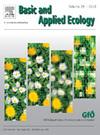通过播种和减少对堤防和洪泛平原草原的管理来增强生物多样性
IF 3.5
2区 环境科学与生态学
Q2 ECOLOGY
引用次数: 0
摘要
堤岸上和洪泛区的草地具有增强生物多样性的巨大潜力,特别是在城市地区。研究了从集约刈割到减少刈割对植被、一般节肢动物和表足类甲壳类动物群落组成、物种丰富度、Shannon多样性和功能性状的影响。沿着Emscher河和Lippe河,研究了16个地点。“简化管理”的特点是播种本地物种和每年两次割草,并去除切割物,而“集约化管理”包括频繁的割草和覆盖。对最近或几年前建立减少管理的地点进行了调查。与集约管理相比,减少管理增加了物种丰富度,改变了群落组成。植物物种丰富度增加了5.7个百分点,一般节肢动物增加了4.8个百分点,表目瓢虫增加了0.7个百分点。在短期和长期的实施中没有观察到显著的差异。在集约化管理的样地中,野生植物和抗逆性植物占主导地位,而在减少的样地中,昆虫和洪泛平原特有的瓢虫的取食类型更为专门化。较大的单伏节肢动物在减少的地点更常见。播种本土草原物种,将集约化管理转变为减少刈割,可以增加生物多样性,有利于专科物种。这种效果在实施后的短时间内达到,并在长期内保持有效。因此,从集约化管理向简化管理转变是提高城市洪泛平原草原生物多样性和恢复力的重要战略。本文章由计算机程序翻译,如有差异,请以英文原文为准。

Enhancing biodiversity through sowing and reduced management of grasslands on dikes and floodplains
Grassland on dikes and in floodplains offers great potential to enhance biodiversity, particularly in urban areas. This study investigates the effects of changing the management from intensive mowing to reduced management on community composition, species richness, Shannon diversity, and functional traits for vegetation, general arthropods, and epigean carabids. Along the rivers Emscher and Lippe, 16 sites were studied. Reduced management’ was characterized by sowing native species and mowing twice annually with cutting removal, while intensive management’ included frequent mowing and mulching. Sites were investigated where reduced management was established recently or several years ago. Reduced management increased species richness and altered community composition across all groups compared to intensive management. Plant species richness increased by 5.7, general arthropods by 4.8, and epigean carabids by 0.7. No significant differences were observed between short- and long-term implementation. Ruderal and stress-tolerant plant species dominated vegetation in intensively managed sites, while reduced sites supported more specialized feeding types across insect species and floodplain-specific carabids. Larger, univoltine arthropods were more common in reduced sites. Sowing native grassland species and changing the management from intensive to reduced mowing can increase biodiversity and favor specialist species. This effect is achieved within a short time after implementation and remains effective in the long term. Conversion from intensive to reduced management is, therefore, an important strategy for increasing biodiversity and resilience of grasslands in urban floodplains.
求助全文
通过发布文献求助,成功后即可免费获取论文全文。
去求助
来源期刊

Basic and Applied Ecology
环境科学-生态学
CiteScore
6.90
自引率
5.30%
发文量
103
审稿时长
10.6 weeks
期刊介绍:
Basic and Applied Ecology provides a forum in which significant advances and ideas can be rapidly communicated to a wide audience. Basic and Applied Ecology publishes original contributions, perspectives and reviews from all areas of basic and applied ecology. Ecologists from all countries are invited to publish ecological research of international interest in its pages. There is no bias with regard to taxon or geographical area.
 求助内容:
求助内容: 应助结果提醒方式:
应助结果提醒方式:


